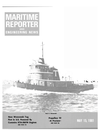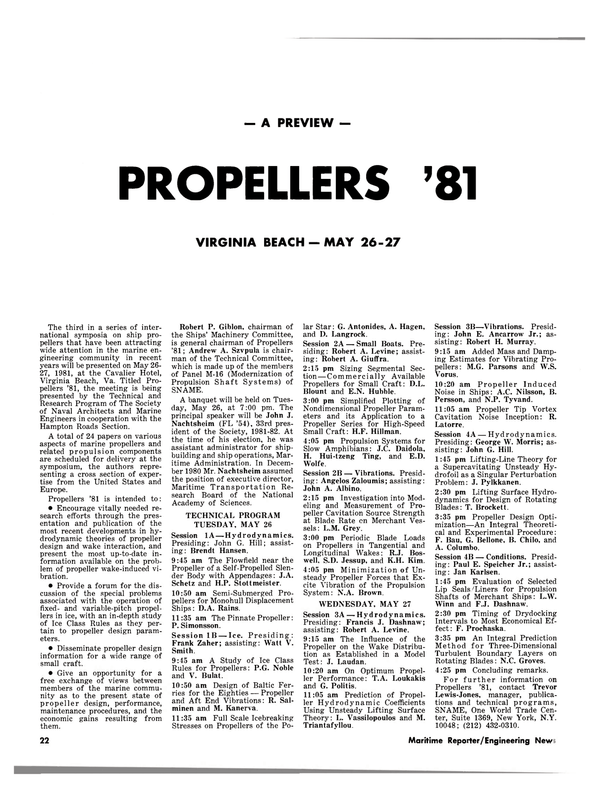
Electric Propulsion Systems Discussed At SNAME Chesapeake Section
A recent meeting of the Chesapeake Section, The Society of Naval Architects and Marine Engineers, was held at the Walter Reed Army Medical Center in Washington, D.C., and featured a presentation on electric propulsion systems for naval combatants by Capt. James V. Jolliff of the Naval Sea Systems Command.
Electric propulsion has proven quite successful in the past in such ships as the Maryland class of battleships, the liner Normandie, T-2 tankers, c o n v e n t i o n al submarines, and more recently, the Coast Guard's Polar class icebreakers.
Based on arrangement, flexibility, operational flexibility, speed control, and ability to use fixed-pitch propellers with nonreversing prime movers, electric drive is being investigated as a new propulsion option for Navy ships.
In his talk, Captain Jolliff concentrated on "near term" or relatively conventional electric components for use in Navy surface combatants. Advanced concepts, i.e., superconducting machinery, were not discussed as the associated risks are considered to be too high to meet the proposed goal of beginning detail design and construction of an electrical system for preliminary approval for service use (PASU) in Fiscal Year 1986.
The electric propulsion option presented by Captain Jolliff is an integrated system, consisting of three General Electric LM 2500 gas turbines, each driving an 18- mw electric propulsion generator.
The generators feed a propulsion bus that powers two synchronous ac propulsion motors, one on each shaft. The generators and motors have water-cooled stators and aircooled rotors, and the motors are rated at a maximum of 38,000 shp each.
Although the plant appears rather s t r a i g h t f o r w a r d when viewed from a total system viewpoint, a number of new concepts have been included. One of the gas turbines is designated as an integrated cruise unit, and in addition to its propulsion generator it powers a 4-mw ship's service generator through a single reduction gear unit. This ship's service generator is complemented by two 4-mw diesel generator sets when required. Constant frequency is maintained on this unit by utilizing state-of-the-art power conditioners between the cruise generator and the propulsion motors allowing steady speed operation of the gas turbine.
The ship can operate up to 23 knots on the cruise unit, and if additional speed is required one or two boost gas turbine generator sets can be brought on line to supplement the cruise gas turbine generator. With both boost units on line, a sustained speed of 30 knots is achieved. The system is extremely flexible from an arrangements standpoint and can be reconfigured as necessary to obtain maximum performance in the context of speed, endurance and maneuverability. More importantly, the effects of battle damage on the propulsion system can be mitigated by reconfiguring the system around damaged portions by switchboard arrangements resulting in a type of selective degradation.
Read Electric Propulsion Systems Discussed At SNAME Chesapeake Section in Pdf, Flash or Html5 edition of May 15, 1981 Maritime Reporter
Other stories from May 15, 1981 issue
Content
- Megasystems To Supply Monitoring Equipment For 8 Oceangoing Tugs page: 6
- MarAd Study Predicts Big Fuel Savings For Sail Assisted Ships page: 6
- Dr. P.W. Murrill Elected To Tidewater Board page: 7
- Hitachi Zosen Delivers Products Carrier To Panamanian Owner page: 8
- Matson Orders Econics Fuel Optimizers—Reports 3.5% Savings In Fuel page: 8
- Sun Ship Jumboizing 'Lurline' Using Unique "Reverse Launch" page: 8
- Wronowski Fleet Adds First Boat With Cummins KTA-3067M Engines page: 10
- Promet Launches Offshore Supply Vessel For Jackson Marine page: 10
- Big IOT Petroleum Barge Launched At Galveston Shipbuilding page: 12
- SNAME Northern California Section Hears Paper On "Dejumboizing page: 12
- Mobil Orders Sperry Advanced Navigation System For The 'Mobile Search' page: 13
- B&W Delivers Second Panamax Bulker-14 More On Order page: 14
- Promet W i l l Build The First Of Its Kind Of Rig For Elf page: 16
- G l o b a l M a r i n e Oil A n d Gas Unit Names Hatcher President page: 16
- First Saudi-Owned Shipping Company Gets First Vessel page: 18
- Anastasio Elected President Of Marine Concrete Structures page: 18
- C.T. Palo Appointed Marine Superintendent For McAllister-Philadelphia page: 18
- New Catalog Available From WABCO Describes Marine Control Valves page: 18
- McDermott Unit Renamed —Earles And Foster Appointed Senior VPs page: 19
- Electric Propulsion Systems Discussed At SNAME Chesapeake Section page: 20
- New Lifting Technique Lowers Costs In Construction Of Drilling Rigs page: 20
- Far East-Levingston To Build Drillship For Global Marine page: 21
- PROPELLERS '81 page: 22
- T A N O A w a r d e d $1.9-Million Contract By B I W Yard For A u t o m a t i o n Systems page: 24
- Texaco Names Dubuisson To N e w Offshore Post page: 24
- NICOR Expands Offshore Fleet With Acquisition Of Two Additional Companies page: 26
- Grant Hagen Joins Designers & Planners page: 26
- ASNE Delaware Valley Chapter Holds Meeting At Philadelphia Naval Base page: 28
- Admiral D.G. Iselin Joins Raymond Unit page: 28
- Hitachi Completes Combination Cargo Carrier For Galleon Shipping page: 30
- Penco To Market Showa's Fuel Mixing System page: 31
- Global And Japanese Firm Jointly Offer Offshore Production Systems page: 31
- IHI Delivers Japan's Biggest Helicopter Destroyer page: 33
- Sail Systems For Commercial Ships Could Cut Fuel Costs 30% —Literature Available page: 33
- New Brochure On Hoists, Winches And Mooring Systems Offered By Skagit page: 38
- Nuclear-Powered Sub 'Houston' Launched At Newport News Yard page: 39
- Main Iron Works Delivers Alco-Powered 'Karen Ann' To Corpus Christi Marine Services page: 39
- Designers & Planners Completes Replacement Study On Alaska Ferry page: 40
- Fireboat Design Contract To Nickum & Spaulding page: 42
- GM-Powered Towboat 'Jeanie-K' Delivered By Riverway Shipyard page: 42
- Penco Appointed U.S. Agent For Bremer Vulcan page: 42
- DeJong & Associates To Design New Tug Series For Corps Of Engineers page: 44
- Bailey Reorganizes Miami Operations—Paul Gausted Appointed Vice President page: 44
- New Worldwide Service Company Formed By Racal-Decca Group page: 45
- Van Dawark Appointed President Of Dillingham Maritime Division page: 45
- Avondale Gets $300-Million Contract From Exxon For Three Products Carriers page: 46
- Brochure And Technical Data Sheets Describe ZF Marine Gears page: 46
- Admiral Fugaro Named Senior Vice President Of Great Lakes Towing page: 46
- Two Power Plant Barges For The Philippines Completed By Hitachi page: 47
- Acadiana Shipbuilding Completes Yard Expansion page: 48
- MarAd Approves Title XI On Five Beker Vessels page: 48
- Racker And Vincent Named Assistant Vice Presidents At Lykes Bros. Steamship page: 48
- Levingston Lays Keel For First Jackup Rig For Noble Drilling page: 49
- W.R. Laws Elected To Executive VP At Geosource page: 49
- Sause Bros. Barge-Building Facility In Coos Bay Nearing Completion page: 50
- Biggest Stuelckenmast Floating Crane Delivered By Blohm + Voss page: 51
- Sixth Supply Boat Delivered To Marsea Marine By Halter page: 51
- Navy Awards Tracor $7.6-Million Contract page: 52
- N&SA Names Stumbo And Hagemann Vice Presidents page: 53
- Braden Offers New Series Of Improved Winches- Literature Available page: 53
- Two Double-Hull Bunkering Barges Delivered By Nashville Bridge page: 66
- Cummins-Powered 110-Foot 'Comet7 Delivered To Shippen Marine page: 66


